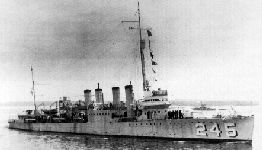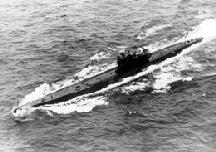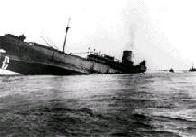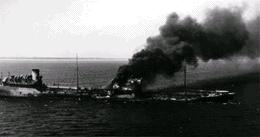
|
Battle of the Atlantic
America Joins the War
Due to American support for British convoys, Donitz had been itching to strike at the “American power”. Although the United States was politically neutral, but its military aid towards the British was viewed by Germany as an increasingly hostile act. The U.S. established several neutrality zones, extending over much of the Atlantic, within which American escorts guarded both British and neutral merchants. American escorts generally did not attack the U-boats they encountered but would broadcast their locations to warn British convoys.
Though neither side was eager to engage in open hostilities, increasing American support of British convoys had led to several clashes. It was difficult for U-boats to distinguish between American and British or Canadian vessels, especially at night or in bad weather. On October 31, 1941, U-552 commanded by KL Erich Topp misidentified the USS Reuben James, sinking the ship in the mid-Atlantic. The Reuben James was the first American naval vessel sunk during the war.
On September 1941, Donitz proposed to the German High Command to deploy U-boats to American waters. This was a pre-emptive move in the event that Germany should go to war with the U.S. But Hitler did not believe a war with the U.S. was imminent and denied permission. Despite escalating tensions between Germany and the U.S., which by this time had led to a state of undeclared war at sea, still Hitler continued to ban any intentional sinkings of U.S. ships.
However all that changed on December 7 1941. The Japanese attack on Pearl Harbor came as a complete surprise to Berlin as it was to other Allied capitals. Although not technically required for the Axis alliance, four days later Germany and Italy declared war on the United States. This declaration would expand the hunting grounds for the Reich’s submarines.

|

|
| The USS Reuben James, seen here on March 9, 1932 on her recommissioning in Philadelphia. She would be the first US warship sunk by a U-boat. | Under operation Drumbeat, A Type IX sails to the US coast. |
Donitz was ready for a new campaign in the west. Dubbed Operation Paukenschlag or Drumbeat, Donitz’s plan for the deployment of U-boats in American waters was complicated by several factors. The extreme distance meant that only the larger Type IX could reach the American coast. Furthermore Donitz wanted to dispatch a dozen of these subs to the American shoreline, but Hitler was unwilling to divert boats from the Mediterranean or Artic. Instead, Hitler ordered even more boats to the Norwegian waters to foil a suspected invasion attempt, leaving only five of the big boats to operate against Germany’s newest and most formidable enemy.
Thus, Donitz grimly prepared for this undermanned operation by handpicking the captains and briefing them on their appointed positions in the Saint Lawrence River and off Cape Hatteras. Their orders were to sink every ship they could find. Commencing on January 13, 1942, the attacks were an immediate success. The U-boat captains could hardly believe their good fortune.
After two years of undeclared war in the Atlantic and a month after Pearl Harbor, the Americans were behaving like it was still peacetime. Large numbers of unescorted ships, their lights on and their crews freely chatting over the radio, gave away their positions. Captains ignored orders to sail without lights because it inconvenienced them and coastal towns eschewed blackouts because it was bad for tourism. Navigational beacons stayed on while American air cover was thin or non-existent. Such was the backdrop of the American situation when this phase of the war began.
U-boat commanders had no problems finding and attacking ships, and because they could not sink all of them, the dilemma was in choosing the best targets. Tonnage figures skyrocketed and soon reached an all time high. The U-boat crews glibly called it the “Second Happy Time” and the “American Shooting Season”.

|

|
| A US freighter goes down off the American coast. | The USS Robert C. Tuttle torpedoed and burning, 1942. |
The first tanker to go down was the Norness on January 14, 1942. Over the next seventeen days, U-boats would send twelve more tankers to the bottom of the sea. The next six months saw wave after wave of German subs sail into American waters and eavesdrop on positioning reports broadcasted over the radio. Although the British had warned of the impending danger of decoded radio signals, the Americans found the idea of U-boats appearing so close to home waters inconceivable. Pressed with the more critical threat of the Japanese fleet, Washington was focused on defeating the island nation in the Pacific theater.
American crews had little experience in hunting subs and, at times, their efforts were somewhat comical. In an anti-submarine operation on February 28, 1942, a Coast Guard Cutter, an aircraft carrier and a navy destroyer hunted and depth-charged an illusionary U-boat – which ultimately turned out to be a whale. Furthermore the Americans operated under the outmoded doctrine of hunter groups, mirroring the same mistake that the British had made earlier.
The U-boats continued their hunting unabated. But the problem for Donitz was the lack of sufficient Type IX boats, which were still the only kind capable of reaching the American coast. Not wanting to lose his window of opportunity Donitz decided to employ the medium range Type VIIs to the American coast. By filling one of their auxiliary water tanks with diesel fuel, the Type VIIs gave themselves enough range to participate in the slaughter.
Meanwhile, Donitz began to position U-boat tankers or “milk cows” in the Atlantic. Able to replenish and refuel submarines at sea, these U-tankers greatly extended the operational coverage and patrol time of the underwater hunters. Soon other types of U-boats, including the coastal Type II, sailed to the lucrative hunting grounds on the American coast. Until the Americans began to institute convoys and organizational tactics developed by the British, there was nothing to stop the Reich’s submarines.
By February 1942, the extent of the carnage was becoming widely known. That month, despite efforts of the military to censor information about sinkings, six merchant ships in New York harbor refused to sail until they were given adequate protection. But the US Navy was not yet organized or educated enough to respond to the U-boat threat. The conventional but absurd wisdom of the time was, “Convoys without escorts are better than no convoys at all”. Merchantmen had to be content with extinguishing their cabin lights, muting the radios, and hoping for the best.
Churchill understood the gravity of the situation and knew that Donitz had found his fertile ground. Though hard pressed from fighting on various fronts, the British sent some Corvettes to help the American situation. Slowly the Americans gained knowledge and sharpened their skills in anti-submarine warfare. As the US organized its forces, Donitz continued to probe American defenses shifting from zone to zone and concentrating on areas not yet prepared for submarine warfare. Attacks would be directed from the Gulf of Mexico through the Florida Coast to the Caribbean Sea and the Atlantic. Gradually U.S. anti-submarine tactics began to improve and combined with the industrial might of the nation, the battle along America’s coast slowly turned. As more American ships sporting new technology became available, the yield for German subs began to drop and the undersea warriors started to take their first losses.
By the close of this campaign, which spanned the first six months of 1942, German U-boats had sunk over 565 allied ships totaling almost 3 million tons. In exchange the Reich had lost only six submarines. Despite the success of Operation Paukenschlag, Donitz understood that the Battle of the Atlantic wasn’t just about sinking ships; its primary purpose was to starve Britain into submission. This goal could only be achieved by severing her convoy routes.
With this in mind he decided to return to the main theater of the North Atlantic with an all out effort to sever the convoy routes linking the UK and North America. Besides, the rising U-boat losses coupled with the long transatlantic journey made operations in American waters unprofitable. Also at this point greater numbers of U-boats were available and new developments in sub technology made them more potent. It was time to return to the main arena.
Despite these favorable conditions, Donitz was a worried man in the summer of 1942. He had cause to be for the tide was about to change.



